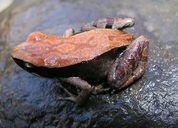|
Description
M ca. 18-21 mm, F ca. 19-26 mm. Back yellowish to reddish or light brown, usually with diamond shaped markings. Strong border between dorsal colouration and the blackish flanks. Light frenal stripe along the upper lip usually until snout tip. Ventral colouration black with blue spots, which are extended onto the throat. Upper half of the iris golden. Tibiotarsal articulation mostly reaches the eye.
Distribution and Habitat
Country distribution from AmphibiaWeb's database: Madagascar
Ambatondradama, Ampoza, Antratrabe, Isalo, Kirindy, Morondava, Tsingy de Bemaraha.
It occurs from sea level to 900m asl in open areas, dry forest, savanna woodland, and degraded habitats (Nussbaum et al. 2008).Life History, Abundance, Activity, and Special Behaviors
Habits: Calling and foraging both during day and night. In Kirindy, highest levels of calling activity were recorded at night near pools. One clutch, containing 35 yellowish eggs was found under a fallen log close to a forest pond.
Calls: Series of short double-click notes.
Breeding occurs in permanent and temporary still waters. The eggs are laid on land near water, and the larvae develop in temporary and permanent pools, and sometimes in brooks (Nussbaum et al. 2008). Trends and Threats
It occurs in many protected areas (Nussbaum et al. 2008). Possible reasons for amphibian decline Intensified agriculture or grazing
Intentional mortality (over-harvesting, pet trade or collecting)
Comments
Taken with permission from Glaw and Vences (2007).
References
Glaw, F., and Vences, M. (2007). Field Guide to the Amphibians and Reptiles of Madagascar. Third Edition. Vences and Glaw Verlag, Köln.
Nussbaum, R., Vences, M., and Andreone, F. (2008). Mantella betsileo. In: IUCN 2008. 2008 IUCN Red List of Threatened Species. www.iucnredlist.org. Downloaded on 21 April 2009.
Originally submitted by: Miguel Vences and Frank Glaw (first posted 2000-12-13)
Edited by: Henry Zhu (2009-05-06)Species Account Citation: AmphibiaWeb 2009 Mantella betsileo <https://amphibiaweb.org/species/4561> University of California, Berkeley, CA, USA. Accessed May 24, 2025.
Feedback or comments about this page.
Citation: AmphibiaWeb. 2025. <https://amphibiaweb.org> University of California, Berkeley, CA, USA. Accessed 24 May 2025.
AmphibiaWeb's policy on data use.
|
